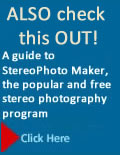|
Viewing Stereo Cards

Brian May, the Queen guitarist, has compiled a book of 59 stereo views of Hinton Waldrist, a small English Village, taken by the Victorian photographer T. R. Williams 150 years ago when photography was still new. The book, "A Village Lost And Found", which May co-wrote with Spanish photo historian Elena Vidal, is an annotated book containing images from Williams' series, "Scenes In Our Village" along with a collapsible viewer. May is certainly no dilettante. He has a doctorate in astrophysics, coauthored "Bang! The Complete History of the Universe" and the rock theatrical "We Will Rock You" and is the chancellor of Liverpool’s John Moores University.

In the first decades of the 19th century, Keystone added an electrical light bulb to their telebinocular stereoscope. It
made viewing dramatically better.

These Educa viewers from France were designed to view glass stereo slides.

This ornate table-top stereo card viewer is called a graphoscope.

An 1860s ad from E. Anthony, a major publisher of stereo cards, that can be viewed in 3D.
Although it’s possible to freeview side-by-side stereo pairs, that’s not what made them so popular from the 1850s to the 1930s. It was the stereo card and viewers that did that—making the images easier to fuse and magnified them to reveal greater detail. Traditionally the cards were cardboard with a standard width of 7 inches so they fit into standard viewers of that width.
The Original Cards
Stereo images have been around since the dawn of photography and the earliest versions such as stereo Daguerreotypes and ambrotypes are very rare. Less expensive albumen stereoviews came later and were mass produced from the 1860s to the 1890s and are much more common. The earliest albumen mounts were cream or white, lightweight and flat with square corners. In the late 1860s heavier mounts with rounded corners became popular. The color of these cards at first was a pale yellow but over the years changed to bright yellow and orange. From the late 1870s on, mounts were curved to enhance the 3D effect. Most stereoviews from the 1890s on are gelatin silver prints usually mounted on curved dark grey mounts.
The first American publisher of stereo views was the Philadelphia firm of the Langenheim brothers Frederick and William. They produced both glass and paper stereographs starting in 1850. Their first set of paper views depicted sites in Philadelphia, New York City, and tourist spots along the route to
Niagara Falls.

Holmes viewer as originally designed in 1859 (left) and modified when manufactured by Bates of London.

A Langenheim stereo view of the suspension bridge over the Niagara River in 1856 is faded but still impressive. Courtesy of the Library of Congress.

Vintage stereo cards are designed for parallel viewing with a viewer of some kind—usually a Holmes viewer.
The Original Viewer
Vintage stereocards, like those found in antique stores and on eBay, have about 3 inch center to center separation between the images which means most people would have to diverge their eyes to fuse them. Even if they could freeview these cards it would get tiring after awhile. However, the cards were designed to be viewed in a Holmes-like viewer that made viewing much easier. It did so in a number of ways.
- Lenses in the viewer move the focus points of the images farther from your eyes so they don’t have to diverge to see the stereo effect, greatly reducing eye strain.
- The lenses magnify the images so you can see finer details.
- A partition between the images makes it easier to fuse the images because each eye only sees one image, not both. The partition also eliminated ghosting, when an eye sees the image it's not intended to see.
- A slider let's you move the card back and forth to bring it into focus.
These viewers were made in the millions and are common in antique stores and on eBay.

Hand-held Holmes stereoscope, probably late 19th century. This anaglyph is courtesy of Koperczak.

The cover from an early periodical featuring articles illustrated with stereo views from the vast collection of the stereo card publisher Underwood & Underwood. Courtesy of Rob Oechsle ( www.t-enami.org), Okinawa Soba on Flickr. |

